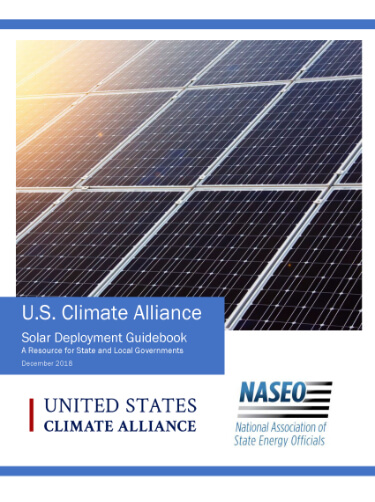Home / U.S. Climate Alliance Announces Release of Clean Energy and Resiliency Resources to Accelerate Climate Action

The U.S. Climate Alliance, a bipartisan coalition of 17 governors committed to upholding the targets of the Paris Agreement, is releasing three clean energy and resilience “playbooks” that will serve as implementation resources for states in deploying solar energy, spurring electric grid modernization, and enhancing resilience in the face of climate impacts and natural hazards. These playbooks are the U.S. Climate Alliance’s latest steps to advance interstate policy solutions that reduce greenhouse gas emissions and grow the economy.
“Reports like the National Climate Assessment underscore the urgency to address climate change. The playbooks released today deliver concrete implementation resources for governors committed to lowering their greenhouse gas emissions and making their state more resilient,” said Julie Cerqueira, Executive Director of the U.S. Climate Alliance.
The playbooks are being released as Governors’ policy advisers from California, Washington, Hawaii, and Maryland are participating in COP24 in a series of climate meetings with international counterparts to discuss collaboration on climate solutions. The U.S. Climate Alliance unveiled plans for the Impact Partnership at COP24, which provides technical, analytical, and other support to the alliance from civil society.
The U.S. Climate Alliance has identified solar deployment, non-wire solutions (NWS), and resiliency as key areas to advance in 2019. The following playbooks are released today to help accelerate state climate action:
“As the Trump Administration continues to backtrack on policies and regulations to protect our air, water and climate, these resources will provide states with blueprints to deploy proven clean energy approaches that benefit the environment and the economy simultaneously,” said Richard Kauffman, Chairman of Energy and Finance, New York State. “The playbooks draw on what U.S. Climate Alliance members are already putting into practice. In New York, non-wires solutions are saving ratepayers hundreds of millions of dollars while spurring the deployment of advanced clean energy solutions. It’s the leadership of state governors like Andrew M. Cuomo of New York that enables states to work together to protect our citizens from the harmful and threatening impacts of extreme weather events due to climate change.”
“To achieve deep emissions cuts, it is really important for states to make their power sectors smarter, cleaner, and more efficient,” said Chris Davis, who is a Senior Advisor to Washington Governor Jay Inslee on Energy and Carbon Markets. “By bringing together best practices and a roadmap to follow, the U.S. Climate Alliance playbooks help states accelerate their climate action.”
“States are facing hotter, wetter and wilder weather, threatening roads, utilities, and other critical infrastructure,” said Ben Grumbles, Chair of the Maryland Climate Change Commission, “Maryland Governor Larry Hogan’s Cabinet agencies recently partnered with the National Governor’s Association for a two day statewide Resilience Summit to instill a culture of preparedness, taking a page out of the Resilient Infrastructure Playbook and building upon our state’s new Climate Leadership Academy.”
At the Global Climate Action Summit in September, the Alliance made new commitments to cut greenhouse gas emissions in a variety of different ways, from reducing short-lived climate pollutants to deploying $1.4 billion to decarbonize transportation. The Alliance is expected to gain new members when a wave of governors take office in early 2019.
Launched in 2017 by the governors of Washington, New York, and California to help fill the void left by the U.S. federal government’s withdrawal from the Paris Agreement, the Alliance has grown to include 24 governors from across the U.S. representing approximately 60 percent of the U.S. economy and 55 percent of the U.S. population. Governors in the Alliance have pledged to collectively reduce net greenhouse gas emissions by at least 26-28 percent by 2025, 50-52 percent by 2030, and 61-66 percent by 2035, all below 2005 levels, and collectively achieve overall net-zero greenhouse gas emissions as soon as practicable, and no later than 2050.
The Alliance’s states and territories continue to advance innovative and impactful climate solutions to grow the economy, create jobs, and protect public health, and have a long record of action and results. In fact, the latest data shows that as of 2023, the Alliance has reduced its collective net greenhouse gas emissions by 24 percent below 2005 levels, while increasing collective GDP by 34 percent, and is on track to meet its near-term climate goal of reducing collective greenhouse gas emissions 26 percent below 2005 levels by 2025.
###